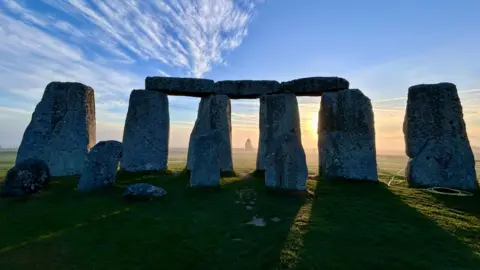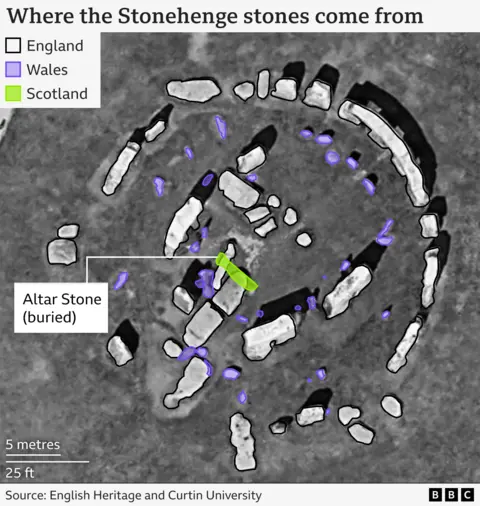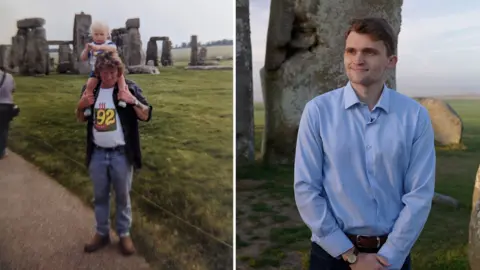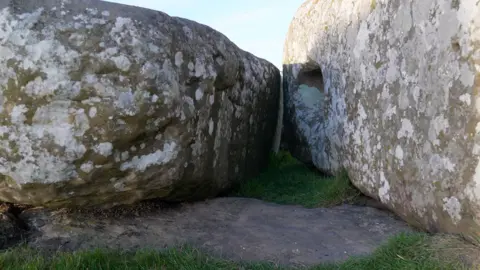 Dawn Pumminster/BBC
Dawn Pumminster/BBCA new analysis has shown that the six-ton altar stone at the heart of Stonehenge comes from the far north of Scotland and not from the southwest of Wales, as previously thought.
The discovery shows that the construction of Stonehenge was a far greater collaborative effort than scientists realized.
It also means that the ancient monument near Salisbury in southwest England was built with stones from all parts of Britain.
The results suggest that society in Neolithic Britain was much better connected and more advanced than previous findings had suggested.
The distance between Stonehenge and the far north of Scotland is about 700 km (434 miles).
The research was led by a Welsh PhD student, Anthony Clarke, who now works at Curtin University in Western Australia.
The significance of this discovery is so great that it was published in one of the world’s leading scientific journals, Naturewhich is an enormous achievement for a budding researcher.
But for the young Welshman, who was born in Pembrokeshire, where the altar stone is believed to have come from, it is a bittersweet moment.
“I don’t think people back home will forgive me,” he joked to BBC News. “It will be a huge loss for Wales!”
However, Mr Clarke points out that the remaining stones in the central horseshoe, known as bluestones, come from Wales and the larger stones in the outer circle come from England.
“We have to offer the Scots something!” he said.
“But seriously, Stonehenge seems to be this big British endeavour involving all sorts of different people from all over the island,” he said.

In 1923, Welsh geologist Henry Herbert Thomas identified the bluestones of Stonehenge as coming from the Preseli Mountains in Pembrokeshire. The central altar stone was made of a different rock, but it was always assumed to have come from the same area until scientists first began to question its origins 20 years ago.
Last year, researchers, including Prof. Nick Pearce from Aberystwyth in Wales, concluded that the The altar stone cannot come from WalesBut its origin remained a mystery until now.
“We were absolutely thrilled when we found out it came from north-east Scotland,” Prof Pearce, who was also involved in the current discovery, told BBC News.
“It was a shock, to say the least. Coming from that distance, more than 700 km, was remarkable.
“The people of the Neolithic period must have been pretty well connected, much better than we give them credit for. They must have been very well organized.”
The breakthrough came from the Curtin University team, who analyzed the chemical composition of rock fragments that had fallen off the altar stone and dated them. The composition and dating are unique to rocks from different parts of the world, much like a fingerprint.
The Australian team had access to one of the most comprehensive global databases of rock fingerprints and found that the best match came from the Orkney Basin, which includes the Caithness, Orkney and Moray Firth regions of northeast Scotland.
 Anthony Clarke
Anthony ClarkeConstruction of Stonehenge began 5,000 years ago and was rebuilt and expanded over the next two millennia. Most of the bluestones are believed to have been the first stones erected on the site.
Dr. Robert Ixer of University College London, who was also involved in the study, described the result as “shocking.”
“The work raises two important questions: how was the altar stone transported from the far north of Scotland, a distance of more than 700 kilometers, to Stonehenge and, even more exciting, why?”
This distance is the longest ever travelled by a stone used for monuments during this period. According to Professor Peace, the next mystery to be solved is how the stone got there.
“There are obvious physical obstacles to transport by land, and the journey by sea is equally daunting.
“These findings will have enormous implications for understanding Neolithic communities, their level of connectivity and their transport systems.”
 Gwynthaf Hughes/BBC
Gwynthaf Hughes/BBCThe new research is being studied in detail by archaeologists at the Stonehenge Museum, English Heritage, said Heather Sebire, one of the monument’s senior curators.
“This discovery certainly suggests that there were great social connections in Britain at that time,” she told BBC News.
“It is phenomenal that people back then brought such a large stone across this path. They must have had a compelling reason for doing so.
“They had a highly developed and sophisticated society and therefore probably had a spiritual side, just like us.”




